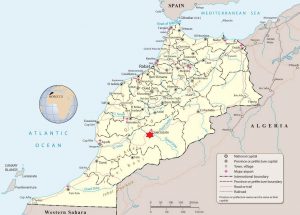Ouarzazate
- Ouarzazate
We left our desert “home” and headed to Ouarzazate. As usual we saw interesting scenery and made several stops along the way. Our first stop was to see a subterranean irrigation water system built in the 14th century, to bring irrigation water from nearby mountains, and mostly abandoned in the 1970’s when a dam began to impact the water table.
- from dry
- to flooding
- desert agriculture
- small town
- our host
- several “wells” accessing underground channels
- drawing water
- entering underground
- underground channel
Besides scenery, we were also interested in some signs. “Allah, Country, King” can be found on many hillsides near towns—to show their allegiance. We also saw the Berber “z” many places—here on the hillsides, but often in paintings, architecture, etc. and on the Berber flag. It is a symbol for the Amazigh (Berber) language and culture.
- Allah, Country, King
- Amazigh Z
- Stop
We stopped at El Khorbat Oujdid, a ksar (fortified village) near Tinejdad. It was built in 1860 and is still inhabited. The ksar is walled and has a number of towers. There was a small museum and some restored houses, a school, and a mosque.
- courtyard of ksar
- alleyways
- school
- rooftop
- rooftop
- residents
Along the way to Ouarzazate, we stopped at a women’s cooperative that makes rose water. Rose water is often used in Moroccan pastries but is also used in cosmetics. (No photos of the actual production!)
- the Cooperative
- benefits of rose water
OAT always has “A Day in the Life” when we visit a local family and participate in some activity. It, hopefully, helps us understand the daily life of a “normal” family. The family also gains as OAT tries to improve their lives. We participated in this experience while at Ouarzazate. On the way to the family, we stopped and saw an artist drawing/painting interesting pictures. He used tea and another ingredient (which we forget). He then held the paper/painting over a fire and part of it turned black.
- holding painting over fire
- finished product
We stopped at our selected home and met the wife, father, and young baby. (The older children were at school.) We helped make bread. We then carried small stools out to the family’s olive grove and had tea and bread. On our return to the house, the father showed us how he makes bricks for building. While we were gone the helpers made couscous, vegetables, and chicken which we ate. It is customary to eat gender-segregated so we did. It is also customary to eat with your fingers but our group has a hard time with that, so the family provided spoons. The children arrived home from school with some of their friends and sang for us. We also had the children and mother join us in “Do The Hokey Pokey.”
- our hosts
- the helpers
- living room
- shaping bread
- bread in oven
- turning bread over
- bread puffs up
- yum!
- going to olive grove for tea
- loaded donkey
- tea
- mixing mud for bricks
- lifting brick form
- couscous & vegetables
- chicken on top
- women of our group
- mother & daughter
- children
We said goody-by to the family and then stopped in town and visited a women’s cooperative that Grand Circle/OAT is supporting. There is a group of about 15 women who have started this cooperative which now includes about 40 women. They run a small bakery and with the help of Grand Circle are moving into a bigger building so that they can expand their activities. They will begin weaving, run a café/gift shop, and have a nursery for the children of the women.
One woman showed us how to make couscous. It is basically flour and water, mixed with your hands and pressed through a sieve. They also painted henna on our hands.
- the Cooperative
- making pastries
- one of the women
- two of the founders
- making couscous
- sifting couscous
- henna
- finished products
- new building
Ouarzazate has been used for a number of movies. Atlas Studios was founded in 1983 and by acreage is the world’s largest film studio. According to Wikipedia some of the movies that have been filmed here are: The Jewel of the Nile, Aladdin (2019 film), Gladiator, Asterix & Obelix: Mission Cleopatra, Game of Thrones, Atlantis, The Amazing Race 10, and many more. Our hotel in Ouarzazate has been used by many movie stars. Artifacts were everywhere in the hotel, including a throne from The Ten Commandments.
- Atlas Studios
- studios
- filming location
- in our hotel


































































